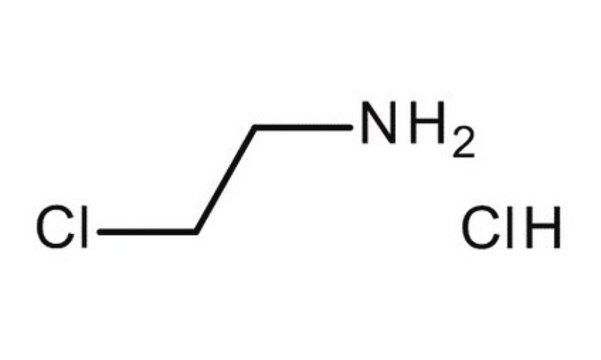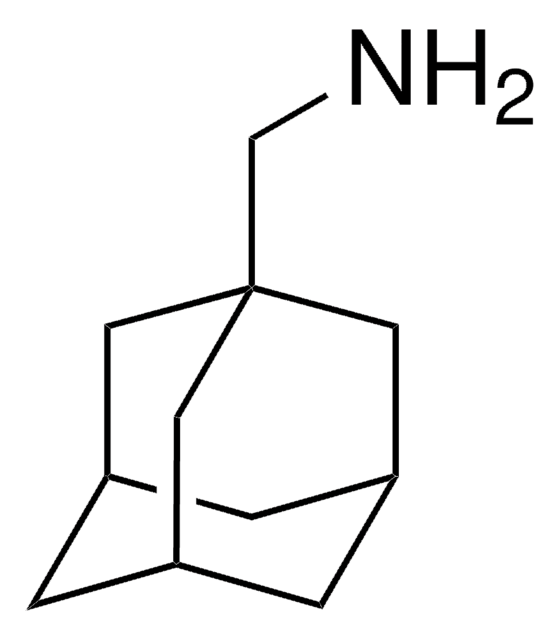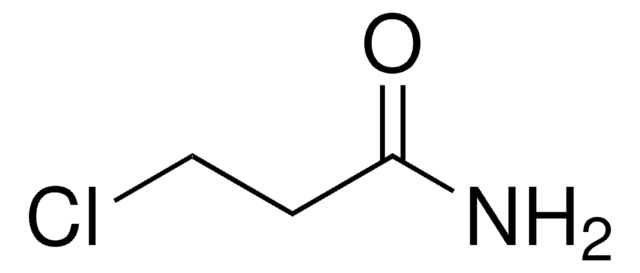142549
3-Chloropropylamine hydrochloride
98%
Synonym(s):
1-Amino-3-chloropropane hydrochloride
Sign Into View Organizational & Contract Pricing
All Photos(3)
About This Item
Linear Formula:
ClCH2CH2CH2NH2 · HCl
CAS Number:
Molecular Weight:
130.02
Beilstein:
3667451
EC Number:
MDL number:
UNSPSC Code:
12352100
PubChem Substance ID:
NACRES:
NA.22
Recommended Products
Quality Level
Assay
98%
mp
145-150 °C (lit.)
functional group
amine
chloro
SMILES string
Cl[H].NCCCCl
InChI
1S/C3H8ClN.ClH/c4-2-1-3-5;/h1-3,5H2;1H
InChI key
IHPRVZKJZGXTBQ-UHFFFAOYSA-N
Looking for similar products? Visit Product Comparison Guide
Application
3-Chloropropylamine hydrochloride was used in chemical treatment of carbon-enriched fly ash concentrates. It was used in the synthesis of linear, star and comb-like polyacrylamides by atomic transfer radical polymerization. It was used in the synthesis of halogen-functionalized aliphatic polyketones (macroinitiators).
Signal Word
Warning
Hazard Statements
Precautionary Statements
Hazard Classifications
Eye Irrit. 2 - Skin Irrit. 2 - STOT SE 3
Target Organs
Respiratory system
Storage Class Code
11 - Combustible Solids
WGK
WGK 3
Flash Point(F)
Not applicable
Flash Point(C)
Not applicable
Personal Protective Equipment
dust mask type N95 (US), Eyeshields, Gloves
Choose from one of the most recent versions:
Already Own This Product?
Find documentation for the products that you have recently purchased in the Document Library.
Customers Also Viewed
Branched polyacrylamides: Synthesis and effect of molecular architecture on solution rheology.
Wever DAZ, et al.
Eur. Polymer J., 49(10), 3289-3301 (2013)
M Mercedes Maroto-Valer et al.
Waste management (New York, N.Y.), 28(11), 2320-2328 (2007-12-21)
Fly ashes with high-unburned-carbon content, referred to as fly ash carbons, are an increasing problem for the utility industry, since they cannot be marketed as a cement extender and, therefore, have to be disposed. Previous work has explored the potential
Polymer Molecular Architecture As a Tool for Controlling the Rheological Properties of Aqueous Polyacrylamide Solutions for Enhanced Oil Recovery.
Wever DAZ, et al.
Industrial & Engineering Chemistry Research, 52(47), 16993-17005 (2013)
Loreta A Muscarella et al.
ACS applied materials & interfaces, 11(19), 17555-17562 (2019-04-17)
We present a one-step method to produce air-stable, large-grain mixed cationic lead perovskite films and powders under ambient conditions. The introduction of 2.5 % of Zn(II), confirmed by X-ray diffraction (XRD), results in stable thin films which show the same
Huikang Yang et al.
International journal of biological macromolecules, 148, 483-492 (2020-01-12)
Redox-responsive theranostic nanoparticles based on poly-(N-ε-carbobenzyloxy-l-lysine) (PZLL) grafted hyaluronan (HA) (HA-g-SS-PZLL) copolymers were constructed for hepatocellular carcinoma diagnosis and therapy. These hyaluronan derivatives formed nanoparticles via a self-assembly process in aqueous solution at low concentration. Theranostic nanoparticles were obtained after
Our team of scientists has experience in all areas of research including Life Science, Material Science, Chemical Synthesis, Chromatography, Analytical and many others.
Contact Technical Service












